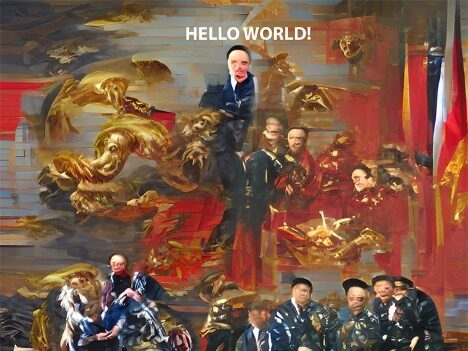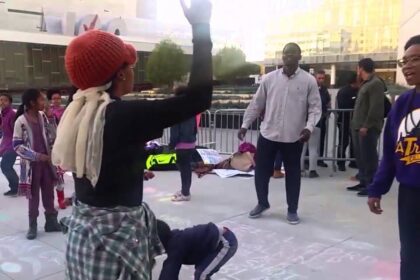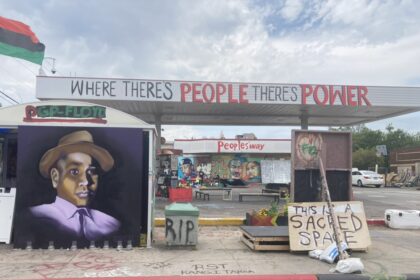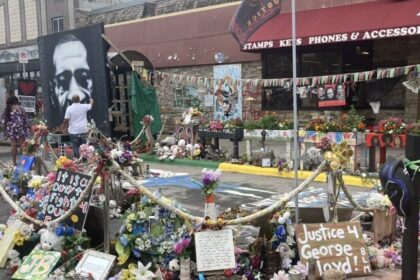Approximating Reality as Decolonial Practice: Almagul Menlibayeva’s AI Realism: Qantar 2022 Series
Bellara Huang
The image Search and seizure. History of Kairat Sultanbek. Kazakh January (2022) bombards the eye with a chaotic interior scene wherein flesh and body parts splay and spill, coloring the walls and floor in an uneven coating of blood and skin. One among fourteen prints in the series AI Realism: Qantar 2022, Almagul Menlibayeva (born 1969, Kazakhstan) creates an image with a compositional logic that yearns to tell a story: what is happening? Who is involved? Where is this? [1] Search and seizure, however, rejects presenting its contents in an expected linear narrative by obscuring faces, generalizing flesh and uniform, and not heroizing figures. Perhaps, Search and seizure references journalism, mocking the superficial layer of objectivity in photographs we see in media outlets. While scrutinizing the image, however, we may identify complex issues beyond the flatness of news photographs presented for an outside gaze: issues surrounding bearing witness, the power to grant or take licenses to information, and, of course, violence resulting from uneven and constructed power. Search and seizure, then, presents a curious tactile surface atop and within the picture plane; the image is an obvious blend of human and algorithmic intimacy. Questions of reality float to the fore: what is truly being described—what is Real—and for whom is the artist depicting?

Menlibayeva created Search and seizure and AI Realism: Qantar 2022 in response to the demonstrations across Kazakhstan that occurred between January 2-11, 2022 known as Bloody January. Protests began in the oil-producing city of Zhanaozen as a sharp increase in liquefied gas prices fueled Kazakh citizens’ rising dissatisfaction with economic inequality. Resistance increased throughout the week as the Kazakh government welcomed Russian armed forces to suppress protesters and issued a five-day Internet blackout starting on January 5. [2] Demonstrations were directed as a result of compounded discontent toward the government, particularly chairman of the Security Council of Kazakhstan Nursultan Nazarbayev, who was the former president between 1991-2019. Even before the dissolution of the Soviet Union, Nazarbayev served as the Prime Minister of the Kazakh SSR since 1984. [3] The nature of economic and political unrest, thus, exists within the larger legacies of Soviet power hegemony in Kazakhstan. [4] Located in Berlin during Bloody January, Menlibayeva’s project serves as a subjective documentation of collective action—a response within the global condition to action in the local level. Making visible, yet not exploiting the violence on the bodies of her communities, Menlibayeva makes apparent to those not immediately subject to these atrocities their alarming proximity to it, spatially, temporally, and digitally. That is, in these images, to some degree, one may find relational and collective consciousness of the violence and oppression that we all have all been subject to—whether that be on our own bodies or within our intergenerational memories—by the modern and colonial matrix of power. [5]
In this essay, I aim to investigate how the artist Almagul Menlibayeva negotiates reality in the process of artmaking, using AI Realism: Qantar 2022 as a case study. I argue that her method not only participates in the process of decolonizing our shared material and digital worlds but also invites the viewer into a transcultural site which delinks with the viewer through the aesthetics of the colonial matrix. In particular, I examine how Menliabayeva teases out the nuances of the global from the universal, delineating the global, in turn, from the colonial. This allows a space for decolonial globalities to work in dialectics with decolonial localities, the latter to which Menlibayeva illustrates with her specific access to Kazakh indigeneity. Ultimately, I argue that precisely in this space, Menlibayeva creates a realism—a method— that reflexively resists coloniality at an integration of both physical and digital processes as well as indigenous and Western aesthetics. I refer to realism not as genre—neither Gustave Courbet’s Stonebreakers (1849) nor socialist realism, the artistic style Menlibayeva trained in. [6] Rather, I clarify realism as a system of approximating one’s experience in an attempt to define what is Real. Realisms are different for every locality, which allows for a multiplicity of realisms, and it is precisely in multiplicity can we work through coloniality, which ontologically and epistemologically eliminates all alternative ways of knowing and being. [7] In essence, I present Menlibayeva’s artmaking process as one that re-futures indigeneity and reaffirms contemporary art as a site for transformative justice, accountability, and joy. To this end, I employ Jacques Lacan’s psychoanalytic study of the Mirror Stage as a framework to explicate digital artmaking processes and their presentation of reality from rational, Eurocentric ontological and epistemological grips. [8] I introduce the question: how do the dimensions of the physical and digital entangle with those of locality and globality?
Hello World? The Computer’s Mirror Stage, or Lack Thereof
Using the string of words ‘_postsoviet kgb_chinese red communist party_greets_olympicgames_2022_,’ Menlibayeva created the image Hello World! using an artificial intelligence (AI) program. [9]

In the image, the white words “Hello World!” recall a specific pedagogical practice in the computer science community: the “Hello, World!” program. This program is the simple printing of the words “Hello, World!” on the screen. An institutional exercise, the program is often the first a student learns in any given coding language to familiarize themselves with the syntax. [10] That the words of this compulsory program read “Hello, World!” tie the project of the computer to that of the Enlightenment. The legitimization of colonial control was built on Western Europe’s classification of the world impelled by the sudden encounters with non-European land and people: literally hello, world! [11] Built with scientific rationality as its scaffolding, the computer certainly prescribes only one nature of interacting with it and only one way of navigating within it (ontology). On the flipside, those who construct the computer and its functions—knowledge that is intentionally inaccessible to the user—utilize only one source of knowledge: coding languages developed in English (epistemology). The computer as a system, moreover, serves as a colonial tool in the aesthetics of the everyday. Many argue that digital citizenhood embodies the democratic view that each user occupies an equal position in the digital. [12] Western hegemony that dictates who gets access to this “democratic” space on the global scale, however, is one and the same as the institution of science that presented non-European others as less developed, less able to be intelligent, and less rational. [13] Cyberspace, as a result, can never separate itself from the politics of representation precisely because it is a projection of the conflicts of class, gender, and race that technology both encodes and seeks to erase. [14] For those who can enter the digital space, the illusion of leaving the physical world masks coloniality par excellence.
Hello World!, however, makes explicit that the image is not a departure from the physical world into the digital, as the string of words which construct it are part of the image, located at the bottom. These words are firmly rooted in the legacies of Soviet power, China’s shifting geo-politics, and the global arena of the Olympics, which, once again, is a modern nineteenth-century European appropriation of the ancient Greek tradition projected onto the rest of the world. [15] Here, I suggest that a psychoanalytical reading of the computer parses the relationship between the physical and digital. Using the psychology of infant behavior, Lacan asserts that the ways that humans produce meaning, through image and language, are never adequate to describe the Real; yet this inadequacy is not trivial. [16] In Lacan’s analysis, an infant’s encounter with the mirror stage, also known as the imaginary register, occurs when the child begins to recognize themselves in a mirror. Becoming obsessed with their image, an infant becomes aware that they are an autonomous being and separate from their mother. In this awakening of consciousness, image becomes an internal site to project our understanding of self. Here, image is coined as the small Other—Other defined as something external to us. After the mirror stage, the child begins to speak, identifying language as an additional method to describe the self. Now, in the symbolic register for the rest of life, the child becomes socialized to accept rules and norms through the use of language. Language, the big Other, is external to us but exists before and after us. Using image and language are indeed attempts to describe the self, but this description is not the Real. Lacan presents the argument that the Real expression of self exists when we are unaware of that expression—before we reach the mirror stage. [17] Thus, in the imaginary and symbolic orders, we never truly describe the Real but use our tools—language and image—to approximate it. [18] What has this to do with the digital? As early as 1954, Lacan acknowledged that in today’s world of the machine, the paradigmatic case for “symbolic bliss” is the computer. [19] Abstracted outside infant development, symbolic bliss serves to describe the condition in which we may escape reality through some sort of language. [20]
The computer, thus, is a space where people attempt to elude physical reality. It is the illusion that a technologically mediated experience can transcend the ecological and economic constraints that have shaped and continue to shape human culture. [21] Slavoj Žižek explicates, however, that digital approximation of reality is no closer to the Real than that of our physical reality. He asks, how does one “think with a computer” as a language in the symbolic register? [22] Žižek discerns the very core of human dialogue with the computer: “we conceive of a world in which all is possible, we can arrange the rules arbitrarily, the only predetermined thing is that these rules must then apply, i.e., that world must be consistent in itself.” [23] Here, however, Žižek notes that the computer, while at the core is a project of semblance with the human mind, lacks the ability to find the point of nonconsistency, the point at which the system is caught in the trap of its own self-referentiality and starts to turn in a circle. [24] In other words, the computer cannot refer to our lived, physical world on Earth by itself. To backtrack to Lacan, I argue that Žižek means that the computer, precisely, does not have a Mirror Stage—it has no self, and, precisely, it doesn’t think. [25] Therefore, computer-generated “virtual reality” is a semblance that forecloses the Real, yet what we experience as the “true, hard, external reality” is based upon exactly the same exclusion. [26] That is, the digital approximation is not a closer one to the Real; our physical reality is just as virtual as our virtual reality.
Menlibayeva’s Symbolic Register
That Menlibayeva’s Hello World! explicitly embeds the string that helped produce the image in the image constructs an artistic symbolic bliss that neither favors the digital over the physical nor attempts to escape reality altogether. Extending psychoanalysis on Menlibayeva’s position can shift the investigation from approximating the Real, which is not trivial since we cannot truly describe it, to how she describes the Real—to which I argue is through a decolonial methodology. One can identify Menlibayeva’s small Other—her internal mirror—on the surface of the image of The story of Laylim Abdildayeva, while her big Other—language—exists in the process of creation. [27]

The story of Laylim Abdildayeva presents the experience of Bloody January as a protester. The image presents a disorienting scene that insinuates an uneven exercise of power between a police or military officer and Abdildayeva. Simultaneous interactions between the two populate the scene in abstract movement, with blood splattering in midair. How does this image exist in the symbolic?
Recall Lacan’s small and big Other—image and language; these Others are that which we describe as self. Image, thus, is not a literal “image” (e.g. photo) but, rather, our internal mirror. In decolonial terms, the image can be where we agentively define what we look like to ourselves, in our own ontologies or ways of being. In The story of Laylim Abdildayeva, Menlibaeva projects internal self as a storyteller of Bloody January as well as a larger protester aligned with the collective discontent toward Kazakh government and the residues of Soviet imperialism. [28] Moreover, the other Other, language, refers not to speaking but the method by which we interact with the rules and norms of society that have existed before us and will continue after us. This, I believe, includes how we resist those rules. Decolonial language is our interaction with the aesthetics of the colonial matrix. It was during the Internet blackout that Menlibayeva embarked on this series—as a member of Kazakh activist communities but residing in Berlin, she felt the shift in movement and travel of conversations, stories, and experiences describing the events across Kazakhstan and its diaspora. [29] Menlibayeva spoke with her friends in Kazakhstan about their experiences in the demonstrations; she garnered stories from Facebook posts of those in her network. Selecting strings of words spoken or written by others, Menlibayeva input them into an AI program. The program then brought up images associated with those terms; each iteration of a search would bring up different images. Menlibayeva would use words in Russian and Kazakh, and the text in different languages contained links to different networks on the Internet, producing yet further different assortment of images. Finally, Menlibayeva used these images to create a composite picture, “feeding” her own style. [30] The artist’s process as a symbolic language thus consists of multiple agents: the artist and her selection of words and the final style, the AI machine and its hyperlinked network with the rest of the Internet and its constant movement, and the encoding of actions that thousands of Kazakh protesters conducted in opposition to governmental control. In other words, Menlibayeva’s approximation of the Real is necessarily rooted in an integration of physical and digital realities; this language, furthermore, does not attempt to escape the colonial reality but, rather, produces a decolonial alternative in digital space. Menlibayeva’s AI Realism images are just as decolonial in the digital as our physical interactions with them on the screen.
Menlibayeva’s decolonial interactions in digital spaces exist not only as an artistic practice but also at the intersections of activism and resistance. Hers is one among many grassroots methods developed in recent years that address the potential of social media in connecting individuals and communities of resistance, communicating action and protest, distributing resources for immediate aid and long-term education, archiving alternative histories, and more. Kazakh January, furthermore, illustrates civil unrest and brutal clampdown characteristic of our contemporary day—particular conditions caused by COVID-19 and its anxieties of bodily and ecological collapse, the protection of the sanctity of nationhood through geo-politics, and global late capitalism (its methods of racialization) in failing to meet the material needs of humans and all living beings alike. In other words, Kazakh January began in response to the same very conditions that define massive resistance and action we have seen across the world since 2020. The pandemic has allowed a collective break in consciousness for many in identifying not only the inadequacy of our institutions but also the conditions by which they position each individual. In this moment, thus, our search for alternative and collective conditions, in Menlibayeva’s case transcultural, are vectors by which we may move through the colonial matrix of power and its grip on our organizations of life. At the heels of employing massive digitalization into daily life, furthermore, the state of a digital condition still leaves gaps. Menlibayeva’s use of this digital space, as it stands largely uncensored yet still surveilled by the state, facilitates resistance akin to that which we have seen in Black Lives Matter and larger movements for racial justice in the United States, for example. Whether conscious of methods in other localities, the phenomenon of social media as a space to serve grassroots resistance to the state exemplifies a global decolonial space—one, once again, that exists and functions in multiplicity.
Meeting with Transcultural Realities through Art
Multiplicity and fragmentation permeate the surface and process of AI Realism. What is it about the materiality of this symbolic language that produces a decolonial interaction with the viewer? On the screen, Menlibayeva creates a zone of contact between the viewer, the artist, and the protestors whose faces and bodies are abstracted. Importantly, this surface presents a new dimension to meet—it deconstructs the colonial power dynamics between the gaze of the looker (subject) and the spectacle of the other (object). In the blended surfaces, furthermore, Menlibayeva constructs a site with the potential of intersubjective contact and mutual change. [31] The use of AI bridges a cultural gap between Kazakh subject (artist and protester) and the viewer (who may be of any background) by utilizing the compositional structure of news and media photographs that overwhelmingly populate the internet. For the viewer, in accepting the familiarity of the composition of images, they make an unspoken acknowledgement of some form of reality experienced by the depicted. In this space, the epistemology of experiencing the other is validified as real, as a reality. In other words, AI Realism embraces the aesthetic expectations of the global consumer through its employment of AI as a tool in digital aesthetics while offering a material representation of protester’s experience intact and inaccessible to those who may exploit it. To illustrate further, in Search and seizure and The story of Laylim Abdildayeva, the image depicts violence, but it does not perpetuate it. It evokes the memory of violence for those who have experienced unjust or terrorizing search and seizure, yet it does not reproduce that violence into spectacle. This space, critically, calls the viewer into a condition of relation that produces affirmation and accountability rather than negation and othering. Menlibayeva’s images present a method of sharing memory visually that not only appropriate the Western tools of photography and artificial intelligence but also turn their colonial functions of policing and controlling on its head. Rather, the images create spatial and temporal multiplicities that evoke the feeling of trauma as cyclically experienced by the viewer, moving toward the recognition of relational and collective consciousness in resistance to colonial violence.
Menlibayeva’s decolonial chimeras—so far, the discussed hybrid of physical and digital—would be amiss without reference to her integration of indigenous Kazakh and Western colonial imagery. One among the AI Realism series, Oligarchic Political Shamanism, ALTAI #2 depicts a modern shaman amidst the landscape of the Altai Mountains. [32]

Here, there is nothing nostalgic about the depiction of this shaman; they are not “from the past” as they are identified, but actually, as the oligarch, a reference to ultra-rich businessmen who have benefited from the fall of the Soviet Union. Like many indigenous figures in her works, Menlibayeva resists presenting a binary good or bad character. The oligarchic shaman seemingly consists of an abstraction of human masses or even non-natural, machine-like elements. Importantly, the artist’s return to Kazakh nomadic imagery is an acknowledgement of alternative ways of being. This radical reimagination re-futures and reaffirms indigenous practices that are surviving, changing, and becoming in the post-Soviet landscape, practices that were made almost obsolete by Soviet modernization and collectivization in the early twentieth century. [33] Importantly, Menlibayeva’s shaman demonstrates neither the rejection of modernity nor the return to pre-colonial way of life. That is, her oligarchic shaman represents the artist’s process of working through coloniality; if the colonial matrix of power extends control by enacting European ontology and epistemology, Menlibayeva’s transcultural process of indigenization provides an alternative. [34]
Oligarchic Political Shamanism, ALTAI #2 further demands of the viewer the recognition of some reality. Similar to The story of Laylim Abdildayeva, the image installs a bridge where globality is familiar: the viewer recognizes the problematics of post-Soviet oligarchs as well as the acknowledgement of an ultra-rich Kazakh class, which may remind us of the relationship between all, and especially our own, ultra-rich classes. At the same time, however, the transcultural image entrenches the global viewer with shamanistic text that remains secret. In recognizing the figure as an oligarch, the viewer accepts Kazakh shamanism as possible at the same time, admitting, whether consciously or subconsciously, to ways of being and systems of knowledge alternative to Western ontology and epistemology. This leaves each global viewer to imagine meaning—some form of reality—in relationship to their own understanding and experience. In other words, Menlibayeva connects the viewer’s global conditions with their local conditions in a space that breeds multiple realities, multiple alternatives, and multiple options to move through. Finally, Menlibayeva’s images vibrate into a reciprocal and active practice, made by the viewer with the artist, not to define the Real but to approximate—to project the internal mirror as well as develop a language—the collective self.
Conclusion
Integrating the indigenous and the colonial, in the digital and in the physical, Menlibayeva creates realisms that harbor specificity of one locality in an accessible global language that appropriates the process of artificial intelligence. The AI Realism: Qantar 2022 series becomes a powerful decolonial surface at which the viewer interacts not only with the artist but also with the actions, memories, and stories of protestors, blending the collective resistance in both the physical and the digital. She makes apparent that constructing image and language in the symbolic is not an escape, not a ‘bliss,’ for those who are marginalized. It is a necessary process for survival—to define and project our own images of self against that of coloniality’s.
In the end, Menlibayeva’s realisms exist as constant approximations of the Real, recognizing that a search for perfectly true language, for a perfectly faithful naming of experience, is a totalizing, universalizing, and imperialist one. [35] In its stead, Menlibayeva’s realisms allow space for all global subjects to recognize and accept the epistemology of experiencing other at the individual and collective levels. At the site where difference of other is recognized, in the Bakhtinian sense, true dialogue occurs. [36]
Bellara Huang is a cultural producer with strong interests in the conditions of diaspora, processes of artmaking, and dialogues of reciprocal exchange. Bellara is a child of the Chinese diaspora, coming of age during the pandemic. Bellara studied art history and computer science at Swarthmore College before Bellara completed an MA in History of Art at the Courtauld Institute of Art in London. Now, Bellara finds community in Brooklyn, New York.
Notes
[1] All images in this series were created in 2022. The first half of the title of the series, AI Realism, refers to the term “Artificial Intelligence Realism.” The term “Qantar” in the latter half of the title of the series is the English transliteration of the Kazakh word for “January.” This series references the events that took place between January 2-11, 2022, demonstrations known as Bloody January. All fourteen prints may be found here: AI Realism (almagulmenlibayeva.com).
[2] The timeline of Bloody January is compiled from description of the events on public forums on the Internet including Instagram, Facebook, and Wikipedia, which take as its sources first-hand experience and multiple news reports from within and outside Kazakhstan. Bloody January resulted in 277 deaths and 9,900 arrests.
[3] Nursultan Nazarbayev (born 1940, Kazakh SSR, Soviet Union) held primary power in Kazakhstan from 1984-2019. He was appointed Prime Minister of the Kazakh SSR in 1984, became First Secretary of the Communist Party of Kazakhstan in 1989, and named Kazakhstan’s first president of the Supreme Soviet in 1990. Leading Kazakhstan out of the collapse of the Soviet Union, Nazarbayev served as the president of Kazakhstan between 1991 and 2019. He was succeeded by Kassym-Jomart Tokayev (born 1953, Kazakh SSR, Soviet Union). During the events of Bloody January, Nazarbayeva resigned as the Chairman of the Security Council on January 5 and fled Kazakhstan on January 7.
[4] For scholarship surrounding Russian imperialism in the Russian Empire (1721-1917), see Mark Bassin, Imperial Visions: Nationalist Imagination and Geographical Expansion in the Russian Far East, 1840-1865 (Cambridge, 2009); For scholarship surrounding Russian supremacy as a method of coloniality, see Madina Tlostanova, “Decolonial AestheSis and the Post-Soviet Art,” Afterall vol 48, no. 1 (2019), pp. 100-107 and Madina Tlostanova, What Does it Mean to Be Post-Soviet? Decolonial Art from the Ruins of the Soviet Empire (Durham, NC, 2018).
[5] This essay centers the definition of modernity as synonymous to and indefinable from coloniality. As one structure of control, modernity/coloniality arose from sixteenth-century Enlightenment Europe with the emergence of the Atlantic commercial circuit and conquest of the New World and expanded globally up to this day. In particular, colonial control refers to strategies of domination and exploitation that are founded on the struggle for supremacy in the interrelated spheres: appropriation of land, natural resources; labor and its products; sexuality and reproduction; control of subjectivity, inter-subjective relations; knowledge; and authority in the form of state, military, police. The legitimization of such control was built on the necessity for Western Europe to historicize its own past (colonizing the histories of ancient Greece and Rome as its forefathers) against the classification of the world impelled by and projected upon the sudden encounters with non-European land and people. People with different definitions of the nature of being (ontology) were cast as inferior; their own methods of belief, validity, and theories of knowledge (epistemology) to measure that inferiority were doubly defined against European rationality and as deviant in relation to Greek and Latin categories of thought. See theoretical scholarship by Walter Mignolo, Rolando Vázquez, and Madina Tlostanova. See Walter Mignolo and Robert Vazquez, “The Decolonial AestheSis Dossier,” Resources: online platform, Decolonial Aesthesis, SocialText Collective, July 15, 2013, https://socialtextjournal.org/periscope_article/the-decolonial-aesthesis-dossier/ (30/03/2022), Walter Mignolo and Madina Tlostanova, Learning to Unlearn: Decolonial Reflections from Eurasia and the Americas (Columbus, 2012).
[6] Socialist realism was the institutional stye enforced by the Soviet state that dictated the ideological boundaries by which all artistic, literary, and cultural production adhered in the Soviet Union. Introduced in First All-Union Congress of Soviet Writers in 1934 and lasting until the fall of the Soviet Union in 1991, socialist realism was both strictly imposed by the dictates of the state as well as agentively, in different complexities, complicated and produced by the artists within and outside “Official,” or state regulated organizations. As it pertains to Kazakhstan, contemporary scholars, such as Aliya Abykayeva-Tiesenhausen, argue that the legacy of the genre of Soviet socialist realism in Central Asia serves as a primary method of colonization. For recent exploration of the complexities of artistic agency in socialist realism, see Zhdanov, Andrei, et al. ‘Contributions to the First All-Union Congress of Soviet Writers [Extracts], 1934’ in Russian Art of the Avant-Garde: Theory and Criticism, ed. John E. Bowlt (London, 2017), Aglaya Glebova, “No Longer an Image, Not Yet a Concept”: Montage and the Failure to Cohere in Aleksandr Rodchenko’s Gulag Photoessay,’ Art History 42, no. 2 (2019), pp. 332-36; Leah Dickerman, ‘The Propagandizing of Things,’ in Aleksandr Rodchenko, ed. Magdalena Dabrowski (New York, 1998), pp. 62-99. For recent explorations of socialist realism as a productive phenomenon, see Christina Kiaer, ‘Lyrical Socialist Realism,’ October 147 (2014), pp. 56-77; Christina Kiaer, ‘Was Socialist Realism Forced Labour? The Case of Aleksandr Deineka in the 1930s,’ Oxford art journal 28, no. 3 (2005), pp. 321-345; Susan Reid, ‘Socialist Realism in the Stalinist Terror: The Industry of Socialism Art Exhibition, 1935-41,’ The Russian Review 60, no. 2 (2001), pp. 153-184. To examine the role of exhibitions in dictating the ideological limits of socialist realism, see Masha Chlenova, ‘Staging Soviet Art: “15 Years of Artists of the Russian Soviet Republic,” 1932–33,’ October 147 (2014), pp. 38-55. For definitions of socialist realism enforced by multiple agentive artists collaborating in opposition to formalism, see, Maria Mileeva, ‘The Creative Mistakes of Socialist Realism,’ in New Narratives of Russian and East European Art: Between Traditions and Revolutions, ed. Galina Mardilovich and Maria Taroutina (New York and London, 2019), pp. 136-150. For further sources on the colonial legacies of socialist realism in Central Asia, see Aliya Abykayeva-Tiesenhausen, Central Asia: From Soviet Orientalism to the New Republics (London, 2016).
[7] Walter Mignolo, “Preface to the Dossier, On the de-colonial (II), Gender and Decoloniality.”
[8] Here, I am referring to Rene Descartes’ rationalism, which is the preliminary theory of Western colonial epistemology—this method of understanding knowledge and knowledge production can be identified as one of the justifications against alternative forms of being.
[9] Hello World! is one of 14 prints in the AI Realism: Qantar 2022 (2022) series.
[10] Computer science programs utilize a multitude of different language, which were created for different functions. Languages include Python, C, C+, C++, etc. Similar to spoken languages, each coding language has different syntax and rules to produce meaning. In this case, what is produced are certain functions, certain images, certain procedures. The “Hello, World!” program is the key first program to execute, as it derives the relationship between the language and the screen—the coder becomes familiar with the process of manipulating the language in order to program a function.
[11] Mignolo, “Preface to the Dossier, On the de-colonial (II), Gender and Decoloniality”; Mignolo and Tlostanova, Learning to Unlearn, pp. 8-9.
[12] Mark Poster, “Cyberdemocracy: The Internet and the Public Sphere,” in Reading Digital Culture, ed. David Trend (Oxford, 2001), pp. 259-271.
[13] Angela Saini, Superior: The Return of Race Science (New York, 2019).
[14] Robert Markley, “History Theory, and Virtual Reality,” in Reading Digital Culture, ed. David Trend (Oxford, 2001), p. 299.
[15] The modern Olympics Games were started in 1896 and appropriated the ancient Olympic Games that were held from the eighth century BC to the fourth century AD. The modern Olympics were initiated by French educator and historian Baron Pierre de Coubertin during post-Enlightenment Western European.
[16] Jacques Lacan, “The subversion of the subject and the dialectic of desire in the Freudian unconscious,” in Écritis (1977), pp. 293-325.
[17] Jacques Lacan, “The subversion of the subject and the dialectic of desire in the Freudian unconscious,” in Écritis (1977), pp. 293-325.
[18] Damian Sutton, Susan Brind, Ray McKenzie, The State of the Real: Aesthetics in the Digital Age (New York, 2007), p. 16.
[19] “The Seminar of Jacques Lacan,” Book 11; The Ego in Freud’s Theory and in the Technique of Psychoanalysis (Cambridge, 1988), Chapter XXIII.
[20] Slavoj Žižek, “From Virtual Reality to the Virtualization of Reality,” in Reading Digital Culture, ed. David Trend (Oxford, 2001), p. 18.
[21] Robert Markley, “History Theory, and Virtual Reality,” in Reading Digital Culture, ed. David Trend (Oxford, 2001), p. 299.
[22] Slavoj Žižek, “From Virtual Reality to the Virtualization of Reality,” in Reading Digital Culture, ed. David Trend (Oxford, 2001), p. 19.
[23] Slavoj Žižek, “From Virtual Reality to the Virtualization of Reality,” p. 20.
[24] Here, Žižek is referring to the concepts of “bad infinity” and “proper infinity,” as described by Georg Wilhelm Friedrich Hegel. See Slavoj Žižek, “From Virtual Reality to the Virtualization of Reality,” p. 21
[25] Slavoj Žižek, “From Virtual Reality to the Virtualization of Reality,” p. 21.
[26] Slavoj Žižek, “From Virtual Reality to the Virtualization of Reality,” p. 22.
[27] The story of Laylim Abdildayeva is one among 14 prints in the series AI Realism: Qantar 2022. This print is one among four in this series which tell the story, specifically, of unjust violence towards humanitarians and activists involved in the Bloody January protests.
[28] Legacies of Soviet imperialism in Kazakhstan remain as a complex issue in contemporary Kazakh art communities. For further detail, see Diana T. Kudaibergenova’s articles “Between the state and the artist: Representation of femininity and masculinity in the formation of the ideas of the nation in Central Asia”, “Contemporary Art in Central Asia as an Alternative Forum for Discussion”, “‘My Silk Road to You’: Re-Imagining routes, roads, and geography in contemporary art of “Central Asia”, “Punk Shamanism, revolt and break-up of traditional linkage: The waves of cultural production in post-Soviet Kazakh”, “Fierce Women, Trauma and Body: Why Does Contemporary Art in Kazakhstan Matter?” in Bread & Roses: Four Generations of Kazakh Women Artists, ed. David Elliott, Almagul Menlibayeva, and Rachel Rits-Volloch, exhibition catalogue, Focus Kazakhstan Berlin (Berlin, 2018), pp. 58-63; Bojana Pejić, “The Personal is Still Political: Spaces of Self-Definition,” in Bread & Roses: Four Generations of Kazakh Women Artists, ed. David Elliott, Almagul Menlibayeva, and Rachel Rits-Volloch, exhibition catalogue, Focus Kazakhstan Berlin (Berlin, 2018), pp. 44-55.
[29] Menlibayeva shared that she was in Berlin during Bloody January but participated in its resistance in conversations and engagements online. Almagul Menlibayeva, Zoom interview, 27/04/2022.
[30] Almagul Menlibayeva, Zoom interview, 27/04/2022.
[31] For further reference on the postcolonial method of transculturation, see Bill Ashcroft, “Towards a postcolonial aesthetics,” Journal of Postcolonial Writing 51, no. 4 (April 2015), p. 2.
[32] The Altai Mountains are a mountain range in Central and East Asia, where Russia, China, Mongolia, and Kazakhstan converge.
[33] Before the march of modernity reached what is now Kazakhstan, the primary way of life was nomadism: a culture of peoples who do not live in permanent settlement but move cyclically according to their relationship with their livestock, the climate, and the resources of the ecosystems in which they reside. Initially, the Russian Empire began settling on fixed lands, embedding russification through Orthodox Christianity, and constructing railroads. The harshest enactment of colonial control, however, came after the October Revolution of 1917, which established the Bolshevik government, and remained, as a Russian supremacy. The First Five-Year Plan (1928-1932) transitioned land into state-controlled farms, forcing an agrarian way of life. This project violently ordained the settlement of Kazakh nomads on fixed lands. The initial failures of collectivization, furthermore, brought the Asharshylyk Famine of 1931-1933, killing one and a half to two million ethnic Kazakhs. See Anatoly M. Khazanov, “The ethnic problems of contemporary Kazakhstan,” Central Asian Survey 14, no. 2 (1995), p. 244; Vera Tolz Russia’s Own Orient: The Politics of Identity and Oriental Studies in the Late Imperial and Early Soviet Periods (Oxford, 2011); Terry Martin, The Affirmative Action Empire: Nations and Nationalism in the Soviet Union, 1923-1939 (Ithaca and London, 2001); Yelena Nikolayevna Zabortseva, Russia’s Relations with Kazakhstan: Rethinking Ex-Soviet Transitions in the Emerging World System (London, 2016), pp. 51-55.
[34] Alternatives, precisely, are necessary in the process of decolonization. Walter Mignolo and Roberto Vazquez discuss the importance of creating alternatives in Walter Mignolo and Roberto Vazquez, “Decolonial AestheSis: Colonial Wounds/Decolonial Healings,” Resources: online platform, Decolonial Aesthesis, SocialText Collective, July 15, 2013, https://socialtextjournal.org/periscope_article/decolonial-aesthesis-colonial-woundsdecolonial-healings/ (accessed 30/03/2022).
[35] Donna Haraway, “A Manifesto for Cyborgs” in Reading Digital Culture, ed. David Trend (Oxford, 2001), p. 33.
[36] Mikhail Bakhtin, The Dialogic Imagination: Four Essays, trans. Caryl Emerson and Michael Holquist (Austin, 1981).











